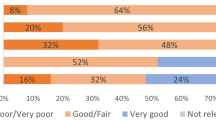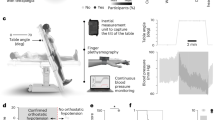Abstract
Study design:
A systematic search of the literature.
Objectives:
To critically review instruments that assess participation in persons with spinal cord injury (SCI).
Setting:
Vancouver, British Columbia.
Methods:
Four electronic databases (MEDLINE/PubMed, CINAHL, EMBASE and PsychInfo) were searched for studies published between 1980 and March 2008. Instruments were included if information was published in English in at least one peer-reviewed journal on its measurement properties (reliability, validity and responsiveness) in a sample that included adults with SCI. Instruments were evaluated using criteria proposed for disability outcome measures.
Results:
Six instruments were included: Craig Handicap Assessment and Reporting Technique (CHART); Impact on Participation and Autonomy Questionnaire (IPA); Assessment of Life Habits Scale (Life-H); Occupational Performance History Interview; Physical Activity Recall Assessment for People with Spinal Cord Injury; and Reintegration to Normal Living Index. Evidence supporting the reliability of the instruments was reported for four of the six instruments and was adequate. Validity was assessed in all the instruments. Only the Life-H and CHART have been compared with each other. No evidence on responsiveness was available.
Conclusion:
The instruments differ in how participation is operationalized. Currently, the CHART that measures objective aspects of participation has the most evidence supporting its measurement properties. More evidence is becoming available for instruments such as the IPA, which consider the person's perspective. It is important to determine what information about participation is required before selecting an instrument.
Sponsorship:
Rick Hansen Foundation, Ontario Neurotrauma Fund.
Similar content being viewed by others
Log in or create a free account to read this content
Gain free access to this article, as well as selected content from this journal and more on nature.com
or
References
World Health Organization. World report on Disability and Rehabilitation: Concept Note. World Health Organization: Geneva, 2006.
Nagi SZ . Some conceptual issues in disability and rehabilitation. In: Sussman MB (ed). Sociology and Rehabilitation. American Sociological Association: Washington, DC, 1965, pp 100–113.
World Health Organization. International Classification of Functioning, Disability and Health. World Health Organization: Geneva, 2001.
World Health Organization. International Classification of Impairments, Disabilities and Handicaps. A Manual of Classification Relating to Consequences of Diseases. World Health Organization: Geneva, 1980.
Whiteneck GG, Charlifue SW, Gerhart KA, Overholser JD, Richardson GN . Quantifying handicap: a new measure of long-term rehabilitation outcomes. Arch Phys Med Rehabil 1992; 73: 519–526.
Noreau L, Fougeyrollas P, Post M, Asano M . Participation after spinal cord injury: the evolution of conceptualization and measurement. J Neurol Phys Ther 2005; 29: 147–156.
Cardol M, de Haan RJ, de Jong BA, van den Bos GA, de Groot IJ . Psychometric properties of the Impact on Participation and Autonomy Questionnaire. Arch Phys Med Rehabil 2001; 82: 210–216.
Carr AJ, Thompson PW . Towards a measure of patient-perceived handicap in rheumatoid arthritis. Br J Rheumatol 1994; 33: 378–382.
Perenboom RJ, Chorus AM . Measuring participation according to the International Classification of Functioning, Disability and Health (ICF). Disabil Rehabil 2003; 25: 577–587.
Reinhardt JD, Stucki G . Rheumatoid arthritis and participation—the social animal revisited. J Rheumatol 2007; 34: 1214–1216.
Messick S . Validty of psychological assessment: validation of inferences from persons’ responses and performance as scientific inquiry into score meaning. Am Psychol 1995; 50: 741–749.
Streiner DL, Norman GR . ‘Precision’ and ‘accuracy’: two terms that are neither. J Clin Epidemiol 2006; 59: 327–330.
Miller WC, Curt A, Elliott S, Hsieh JTC, Mortenson WB, Noonan VK et al. Outcome measures. In: Eng J, Teasell R, Miller W, Wolfe D, Townson A, Aubut J et al. (eds). Spinal Cord Injury Rehabilitation Evidence. ICORD: Vancouver, BC, 2006, chapter 22, pp 1–89.
Australian Institute of Health and Welfare (AIHW). ICF Australian User Guide. Version 1.0. Australian Institute of Health and Welfare: Canberra, 2003.
Catz A, Itzkovich M, Tesio L, Biering-Sorensen F, Weeks C, Laramee MT et al. A multicenter international study on the Spinal Cord Independence Measure, version III: Rasch psychometric validation. Spinal Cord 2007; 45: 275–291.
Post MW, de BA, de WL, Schrijvers A . The SIP68: a measure of health-related functional status in rehabilitation medicine. Arch Phys Med Rehabil 1996; 77: 440–445.
Andresen EM . Criteria for assessing the tools of disability outcomes research. Arch Phys Med Rehabil 2000; 81: S15–S20.
Tasiemski T, Kennedy P, Gardner BP, Blaikley RA . Athletic identity and sports participation in people with spinal cord injury. Adapt Phys Activ Q 2004; 21: 364–378.
Murphy G, McDonald L, McDonald S . Test re-test reliability of information about employment provided in surveys by people with spinal cord injuries. Psychol Rep 1997; 81: 25–26.
Fougeyrollas P, Noreau L, Bergeron H, Cloutier R, Dion SA, St-Michel G . Social consequences of long term impairments and disabilities: conceptual approach and assessment of handicap. Int J Rehabil Res 1998; 21: 127–141.
Kielhofner G, Henry AD . Development and investigation of the occupational performance history interview. Am J Occup Ther 1988; 42: 489–498.
Ginis KA, Latimer AE, Hicks AL, Craven BC . Development and evaluation of an activity measure for people with spinal cord injury. Med Sci Sports Exerc 2005; 37: 1099–1111.
Wood-Dauphinee SL, Opzoomer MA, Williams JI, Marchand B, Spitzer WO . Assessment of global function: the reintegration to normal living index. Arch Phys Med Rehabil 1988; 69: 583–590.
Cardol M, de Haan RJ, van den Bos GA, de Jong BA, de Groot IJ . The development of a handicap assessment questionnaire: the Impact on Participation and Autonomy (IPA). Clin Rehabil 1999; 13: 411–419.
Whiteneck GG, Brooks CA, Charlifue S, Gerhart KA, Mellick D, Overholser JD et al. Guide for use of the Craig Handicap Assessment and Reporting Technique. Craig Hospital: Englewood, CO, 1998.
Sibley A, Kersten P, Ward CD, White B, Mehta R, George S . Measuring autonomy in disabled people: validation of a new scale in a UK population. Clin Rehabil 2006; 20: 793–803.
Hall KM, Dijkers M, Whiteneck G, Brooks CA, Krause JS . The Craig Handicap Assessment and Reporting Technique (CHART): metric properties and scoring. Top Spinal Cord Inj Rehabil 1998; 4: 16–30.
Pallant JF, Tennant A . An introduction to the Rasch measurement model: an example using the Hospital Anxiety and Depression Scale (HADS). Br J Clin Psychol 2007; 46: 1–18.
Walker N, Mellick D, Brooks CA, Whiteneck GG . Measuring participation across impairment groups using the Craig Handicap Assessment Reporting Technique. Am J Phys Med Rehabil 2003; 82: 936–941.
Tozato F, Tobimatsu Y, Wang CW, Iwaya T, Kumamoto K, Ushiyama T . Reliability and validity of the Craig Handicap Assessment and Reporting Technique for Japanese individuals with spinal cord injury. Tohoku J Exp Med 2005; 205: 357–366.
Cusick CP, Brooks CA, Whiteneck GG . The use of proxies in community integration research. Arch Phys Med Rehabil 2001; 82: 1018–1024.
Lund ML, Fisher AG, Lexell J, Bernspang B . Impact on participation and autonomy questionnaire: internal scale validity of the Swedish version for use in people with spinal cord injury. J Rehabil Med 2007; 39: 156–162.
Noreau L, Fougeyrollas P, Vincent C . The LIFE-H: assessment of the quality of social participation. Technol Disabil 2002; 14: 113–118.
Dumont C, Bertrand R, Fougeyrollas P, Gervais M . Rasch modeling and the measurement of social participation. J Appl Meas 2003; 4: 309–325.
Noreau L, Fougeyrollas P, Labbe A, Laramee MT . Comparison of 2 measurement tools assessing the concept of handicap: CHART and LIFE-H. J Spinal Cord Med 1998; 21: 192.
Noreau L, Fougeyrollas P . Long-term consequences of spinal cord injury on social participation: the occurrence of handicap situations. Disabil Rehabil 2000; 22: 170–180.
Lynch KB, Bridle MJ . Construct validity of the Occupational Performance Interview. Occup Ther J Res 1993; 13: 231–240.
Latimer AE, Ginis KA, Craven BC, Hicks AL . The physical activity recall assessment for people with spinal cord injury: validity. Med Sci Sports Exerc 2006; 38: 208–216.
May LA, Warren S . Measuring quality of life of persons with spinal cord injury: external and structural validity. Spinal Cord 2002; 40: 341–350.
Whiteneck G . Conceptual models of disability: past, present, and future. In: MJ Field, AM Jette, L Martin (eds). Workshop on Disability in America: A New Look. National Academies Press: Washington, DC, 2006, pp 50–66.
Nordenfelt L . Action theory, disability and ICF. Disabil Rehabil 2003; 25: 1075–1079.
Jette AM, Tao W, Haley SM . Blending activity and participation sub-domains of the ICF. Disabil Rehabil 2007; 29: 1742–1750.
Cieza A, Brockow T, Ewert T, Amman E, Kollerits B, Chatterji S et al. Linking health-status measurements to the international classification of functioning, disability and health. J Rehabil Med 2002; 34: 205–210.
Cieza A, Geyh S, Chatterji S, Kostanjsek N, Ustun B, Stucki G . ICF linking rules: an update based on lessons learned. J Rehabil Med 2005; 37: 212–218.
Dijkers MPJM, Yavuzer G, Ergin S, Weitzenkamp D, Whiteneck GG . A tale of two countries: environmental impacts on social participation after spinal cord injury. Spinal Cord. 2002; 40: 351–362.
Fuhrer MJ . Subjective well-being: implications for medical rehabilitation outcomes and models of disablement. Am J Phys Med Rehabil 1994; 73: 358–364.
Magasi SR, Heinemann AW, Whiteneck GG . Participation following traumatic spinal cord injury: an evidence-based review for research. J Spinal Cord Med 2008; 31: 145–156.
Gray DB, Hollingsworth HH, Stark SL, Morgan KA . Participation Survey/Mobility: psychometric properties of a measure of participation for people with mobility impairments and limitations. Arch Phys Med Rehabil 2006; 87: 189–197.
Brown M, Dijkers MP, Gordon WA, Ashman T, Charatz H, Cheng Z . Participation objective, participation subjective: a measure of participation combining outsider and insider perspectives. J Head Trauma Rehabil 2004; 19: 459–481.
Gandek B, Sinclair SJ, Jette AM, Ware Jr JE . Development and Initial Psychometric Evaluation of the Participation Measure for Post-Acute Care (PM-PAC). Am J Phys Med Rehabil 2006; 86: 57–71.
Ostir GV, Granger CV, Black T, Roberts P, Burgos L, Martinkewiz P et al. Preliminary results for the PAR-PRO: a measure of home and community participation. Arch Phys Med Rehabil 2006; 87: 1043–1051.
Pallant JF, Misajon R, Bennett E, Manderson L . Measuring the impact and distress of health problems from the individual′s perspective: development of the Perceived Impact of Problem Profile (PIPP). Health Qual Life Outcomes 2006; 4: 36.
Sandstrom M, Lundin-Olsson L . Development and evaluation of a new questionnaire for rating perceived participation. Clin Rehabil 2007; 21: 833–845.
Van Brakel WH, Anderson AM, Mutatkar RK, Bakirtzief Z, Nicholls PG, Raju MS et al. The Participation Scale: Measuring a key concept in public health. Disabil Rehabil 2006; 28: 193–203.
Wilkie R, Peat G, Thomas E, Hooper H, Croft PR . The Keele Assessment of Participation: a new instrument to measure participation restriction in population studies. Combined qualitative and quantitative examination of its psychometric properties. Qual Life Res 2005; 14: 1889–1899.
Acknowledgements
Funding for this project was provided by the Rick Hansen Man in Motion Research Foundation and the Ontario Neurotrauma Foundation. VKN is supported by a Canadian Institutes of Health Research (CIHR) fellowship. WCM is a CIHR Institute of Aging New Investigator.
Author information
Authors and Affiliations
Consortia
Corresponding author
Rights and permissions
About this article
Cite this article
Noonan, V., Miller, W., Noreau, L. et al. A review of instruments assessing participation in persons with spinal cord injury. Spinal Cord 47, 435–446 (2009). https://doi.org/10.1038/sc.2008.171
Received:
Revised:
Accepted:
Published:
Issue date:
DOI: https://doi.org/10.1038/sc.2008.171
Keywords
This article is cited by
-
Relevance of the international spinal cord injury basic data sets to youth: an Inter-Professional review with recommendations
Spinal Cord (2017)
-
Phrenic pacing compared with mechanical ventilation
Spinal Cord Series and Cases (2017)
-
Development of the International Spinal Cord Injury Activities and Participation Basic Data Set
Spinal Cord (2016)
-
Cross-Cultural Adaptation, Validity and Reliability of the Escala Pessoal de Resultados
Social Indicators Research (2014)
-
Psychometric Properties of Self-reported Quality of Life Measures for People with Intellectual Disabilities: A Systematic Review
Journal of Developmental and Physical Disabilities (2013)



